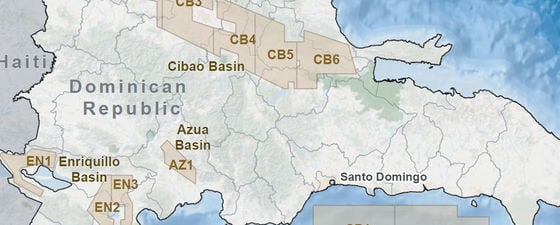The Dominican Republic has just announced its first licensing round, which concludes in December 2019, offering plenty of potential in fourteen blocks.
The Dominican Republic has just announced its first licensing round, which concludes in December 2019. Fourteen blocks are available onshore and offshore; with a flexible contract and an attractive investment environment, the nation is set to open up the Caribbean to new exploration opportunities.
Source: Wood Mackenzie.
The geology of this frontier region is even more reason for investors and operators to be attracted to the Dominican Republic. Features of the basinal setting include:
Subduction of the North America plate below the Caribbean Plate.
Strike-slip, convergent structures produced by strike-slip displacements and transpressional accretion of crustal fragments (Mann and Lawrence, 1991).
Thrust belts developed on both sides of oceanic island arcs.
A north-verging accretionary prism lying to the north of the Eastern Greater Antilles arc.
The presence of crude in the Dominican Republic has been known for decades, as evidenced by the black gold that oozes out of a pit in Charco Largo, Azua, in the south of the country. Three onshore Neogene clastic basins have been the focus of petroleum exploration, and oil seeps led to a well being drilled at Higuerito as far back as 1905, reportedly producing about 40 bpd of oil, although sustained production was not obtained until 1927/8 by Texas Co.
The Dominican Republic occupies the eastern 5/8ths of the island of Hispaniola, in the Greater Antilles archipelago of the Caribbean region. It is the second largest Caribbean nation by area, and third by population. Its capital, Santo Domingo, is home to approximately three million people.
With temperatures averaging 26°C/78.8°F and wide climatic and biological diversity, the Dominican Republic has long been a favorite with tourists from all over the world. In addition, it is an attractive and desirable country for international investment.
On offer are fourteen blocks in four basins, a combination of on and offshore, with a maximum size per block of 500 km2 onshore and 2,500 km2 offshore. Onshore, six blocks are available in the Cibao Basin, three in the Enriquillo Basin and one in the Azua Basin. The four offshore blocks are all located in the San Pedro de Macoris Basin.
Interested companies will be able to nominate new exploration areas and/or propose changes to future blocks on the back of success in this round. Flexible contract terms allow operators to adapt the exploration strategy during the term of the contract.
For more information on the Dominican Republic First Licensing Round, visit: https://www.geoexpro.com/articles/2019/09/the-hydrocarbon-potential-of-the-dominican-republic
Further Reading on the Oil and Gas Potential of the Dominican Republic
The Hydrocarbon Potential of the Dominican Republic
Ministry of Energy and Mines, Dominican Republic with support of Wood Mackenzie
The Dominican Republic has just announced its first licensing round, which concludes in December 2019. With fourteen blocks available on and offshore, a flexible contract and an attractive investment environment, the nation is set to open up the Caribbean to new oil and gas exploration opportunities.
This article appeared in September, 2019





